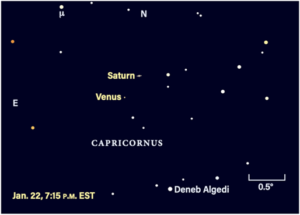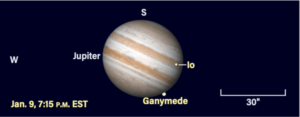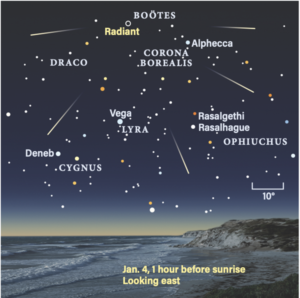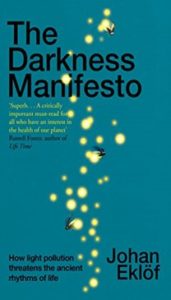January 2023 Dark Skies
Happy New Year to you all!
So, what is 2023 going to bring? There are good planetary viewing opportunities in January if you can get a good gap in the clouds and it stops raining.
Early winter sunsets will offer good evening views of the planets, starting with Mercury and Venus.
Mercury quickly drops away below the horizon, only to reappear in the morning sky before the end of the month. Venus is dazzling in the west and later in the month has a close encounter with Saturn, a stunning sight using binoculars or small telescopes. These cues allow you to observe Saturn and maybe see some of Saturn’s moons. Mars and Jupiter dominate the evening sky. Uranus and Neptune are viewable but can be observed through binoculars or small telescopes.

On Jan. 22, Venus and Saturn are close with luck the rings being viewable. The planets’ sizes are shown here relative to each other – Venus will be a bright object compared to surrounding stars. Please note the directions – north at top!
Saturn dips below the horizon quickly throughout January evenings. Its low altitude/aspect affects telescopic views. Catch it in the first week of January, when it is high in the southwest skies shortly after sunset, glowing at magnitude 0.8. The rings in twilight are a wonderful sight and you have about an hour to observe them before the altitude really begins to affect the view.
Neptune is a relatively easy to find with the binoculars high in the southwest once the sky is dark. Located to the East of Aquarius, this dim, distant planet shines bright at magnitude 7.8 in a region devoid of bright stars.

Jupiter is shining brightly in the southwest throughout January. In 10x 40 Binoculars it is possible to spot Jupiter’s moons. Make this observation a tick on your list for 2023!
Mars is a spectacular object in Taurus, shining brightly a salmon pink colour. Mars lies about 9° east of the Pleiades star cluster (M45). You should know the Pleiades from your Dark Skies watching last year.
Meteor Watch: Catch a few falling stars – the Quadrantids – look East!
This annual winter shower is a regular for observers, but early January’s Full Moon strongly affects viewing this year. The Quadrantids, named after a defunct constellation in what is now northern Boötes, are active from Dec. 28 to Jan. 12, peaking late on Jan. 3.

During my recuperation I have been reading the Darkness Manifesto – it’s a new book looking at aspects of light pollution – I’ll return with a more comprehensive review late January.

From reviews:
Powerful… a clarion call for change’, New Statesman
‘Poetic and philosophical at times, intimate and expansive at others’, Daily Telegraph
How much light is too much light? The Darkness Manifesto urges us to cherish natural darkness for the sake of the environment, our own wellbeing, and all life on earth.
The world’s flora and fauna have evolved to operate in the natural cycle of day and night. But constant illumination has made light pollution a major issue. From space, our planet glows brightly, 24/7. By extending our day, we have forced out the inhabitants of the night and disrupted the circadian rhythms necessary to sustain all living things. Our cities’ streetlamps and neon signs are altering the ecosystems. As a Bat Worker this is a critical issue for me and some of my work.
Johan Eklöf in this book encourages us to appreciate natural darkness and its unique benefits. He also writes passionately about the domino effect of damage we inflict by keeping the lights on: insects failing to reproduce; birds blinded and bewildered; bats starving as they wait in vain for insects that only come out in the dark. And humans can find that our hormones, weight and mental well-being are all impacted.








